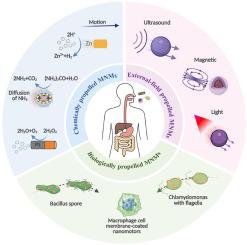微纳米运动技术:提高生物活性物质口服生物利用度的新机遇
IF 15.4
1区 农林科学
Q1 FOOD SCIENCE & TECHNOLOGY
引用次数: 0
摘要
生物活性物质由于具有特殊的生理调节功能,在营养和健康领域具有重要的应用前景。然而,由于各种胃肠道屏障,它们的口服生物利用度通常较低。传统的纳米颗粒给药系统虽然通过包封的方式提高了生物活性物质的口服稳定性和吸收效率,但仍然存在很大的局限性,包括依赖于低效和不可控的被动扩散,易被粘弹性黏液层包裹和清除,缺乏有效的靶向能力。微/纳米马达(MNMs)是一种将外部能量转化为机械运动的微型装置,具有自主运动和靶向递送等独特优势,为克服传统纳米粒子系统的局限性和提高生物活性物质的口服生物利用度提供了一个有希望的解决方案。本文系统地综述了生物活性物质口服给药的主要障碍,重点介绍了各种纳米颗粒在克服多种胃肠道生理障碍方面的推进机制和研究进展。详细分析了在口服给药中使用MNMs的优势和挑战,旨在为生物活性物质的精确、靶向和高效给药提供理论基础和创新策略。smnms可以有效地将外部能量(化学、光、磁或声)转化为自我推进,实现自主导航、穿透屏障和在复杂胃肠道中的靶向蓄积。一些MNMs甚至可以利用胃酸等不利条件作为驱动力,实现有效载荷传递和协同治疗。纳米颗粒具有良好的穿透性、靶向性和可控性,为提高生物活性物质的口服生物利用度提供了一种很有前途的策略。本文章由计算机程序翻译,如有差异,请以英文原文为准。

Micro/nanomotor technology: A new opportunity for enhancing the oral bioavailability of bioactive substances
Background
Bioactive substances hold significant promise in nutrition and health due to their exceptional physiological regulatory functions. However, their oral bioavailability is typically low due to various gastrointestinal barriers. Although traditional nanoparticle delivery systems improve the oral stability and absorption efficiency of bioactive substances through encapsulation, they still face significant limitations, including dependence on inefficient and uncontrollable passive diffusion, vulnerability to entrapment and clearance by the viscoelastic mucus layer, and lack of effective targeting capability. Micro/Nanomotors (MNMs), microdevices that convert external energy into mechanical motion, offer distinct advantages such as autonomous movement and targeted delivery, presenting a promising solution to overcome the limitations of traditional nanoparticle systems and enhance the oral bioavailability of bioactive substances.
Scope and approach
This review systematically summarizes the major barriers to the oral delivery of bioactive substances, with a focus on the propulsive mechanisms and research progress in overcoming multiple gastrointestinal physiological barriers of various MNMs. It provides a detailed analysis of the advantages and challenges of using MNMs in oral delivery, aiming to provide theoretical foundations and innovative strategies for the precise, targeted, and efficient delivery of bioactive substances.
Key findings and conclusions
MNMs can effectively convert external energies (chemical, light, magnetic, or acoustic) into self-propulsion, enabling autonomous navigation, barrier penetration, and targeted accumulation in the complex gastrointestinal tract. Some MNMs can even harness adverse conditions like gastric acid as driving forces, achieving efficient payload delivery and synergistic therapy. With excellent penetration, targeting, and controllability, MNMs offer a promising strategy to enhance the oral bioavailability of bioactive substances.
求助全文
通过发布文献求助,成功后即可免费获取论文全文。
去求助
来源期刊

Trends in Food Science & Technology
工程技术-食品科技
CiteScore
32.50
自引率
2.60%
发文量
322
审稿时长
37 days
期刊介绍:
Trends in Food Science & Technology is a prestigious international journal that specializes in peer-reviewed articles covering the latest advancements in technology, food science, and human nutrition. It serves as a bridge between specialized primary journals and general trade magazines, providing readable and scientifically rigorous reviews and commentaries on current research developments and their potential applications in the food industry.
Unlike traditional journals, Trends in Food Science & Technology does not publish original research papers. Instead, it focuses on critical and comprehensive reviews to offer valuable insights for professionals in the field. By bringing together cutting-edge research and industry applications, this journal plays a vital role in disseminating knowledge and facilitating advancements in the food science and technology sector.
 求助内容:
求助内容: 应助结果提醒方式:
应助结果提醒方式:


